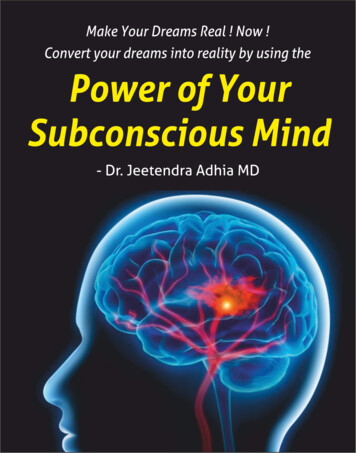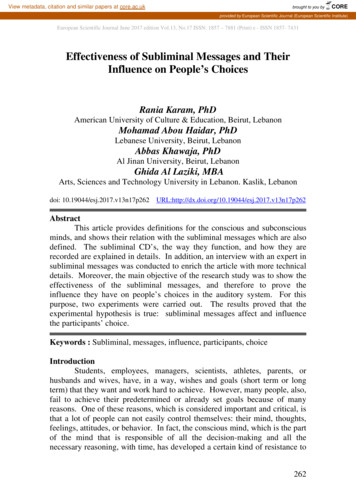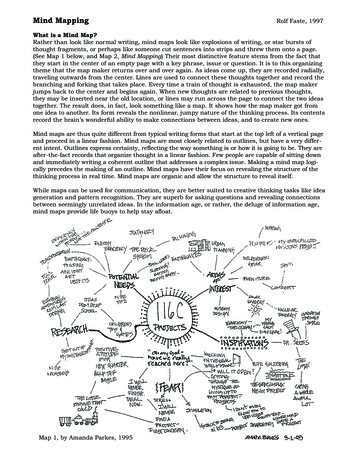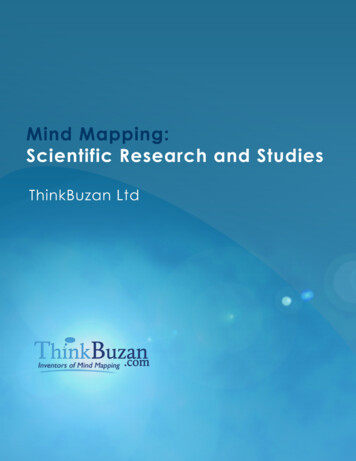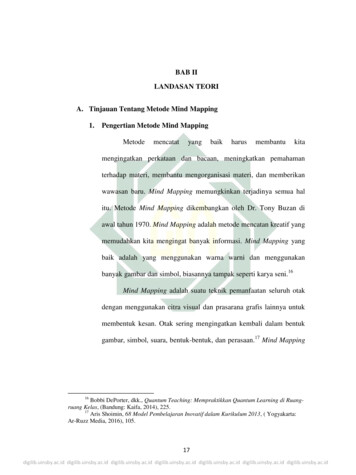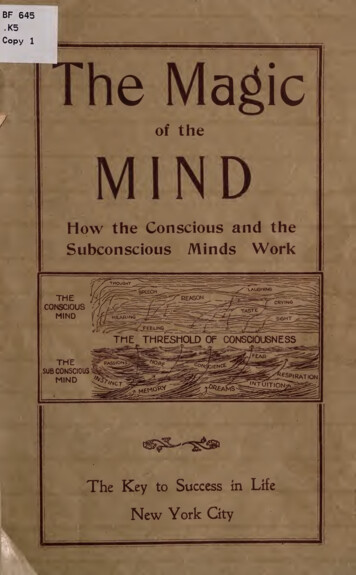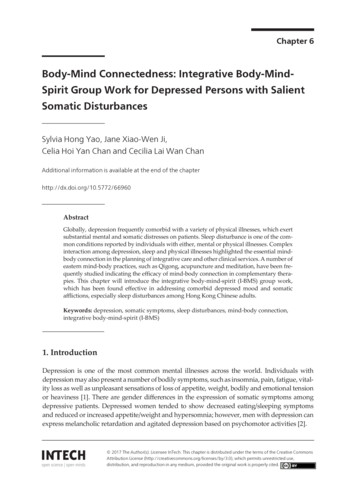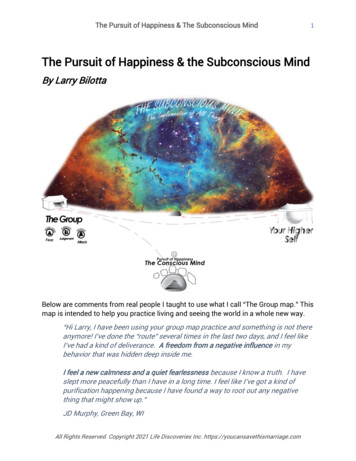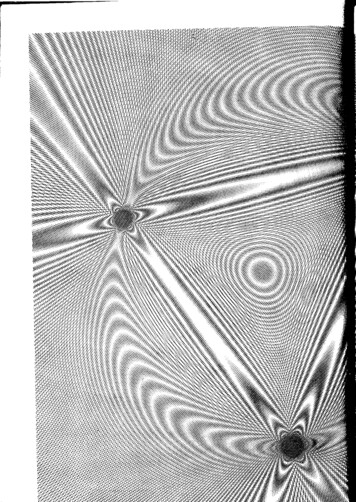
Transcription
MINDANDNATUREANecessary U ni tyGregory BatesonE . P. DUTTON.NewYork
Copyright 1979 by Gregory BateJonAll rights reserved. Printed in the U.S.A.No pat·t of this publicati01l may be reproduced ortratlSlIlltted in any form or by any means, electronic ormechanical. including photocopy, recording or anyin/ormation storage and retrieval system now knoum or tobeinvented. without permission in writing from the publisher,except by a reviewer u-ho wishes to quote brief pm'sagesin connection with a review written for inclusion ina magazine. newspaper or broadcast.For information (Ontin!:E. P. Dutton, 2 Park Avenue,New York, N. Y. 10016Library of Congress Cataloging in Publication DataBateson, Gregory.Mind and nature.Includes index.I. Knowledge, Theory ofBDIGI.B321978I. Tit/e.121ISBN: 0-525-15590-2Published simultan",,,sly in Canada byCla/h, Irwin& Company Limited,Toronto and Vancou.'erDe;igned by The Etheredges10 9 8 7 6 5 4 378-14796
For:NoraVanniGregoryEmily Elizabeth
CONTENTSAcknowledgmentsI.II.xiI ntroductionEvery Schoolboy KnowsIII.Multiple Versions of the WorldIV.Criteria of Mental ProcessV.Multiple Versions of RelationshipVI .The Great Stochastic ProcessesVII .From Classification to ProcessVII I .6589Appendix: Time Is Out of JointI ndex14518 7203So What?Glossary1292252312I5
J
ACKNOWLEDGMENTSThe work and thought leading to this book have spreadover many years, and my debts go back to include allthat were acknowledged in the preface to my previousbook, Steps to an Ecology 0/ Mind. But I have tried towrite to be understandable to those who have not readthereforeshall acknowledge here only debts contracted sinceSteps andSteps was published .Even so , recent favors have been many. In something like chro nological order, I have to thank first the fellowship of the University ofCalifornia at Santa Cruz and especially my friends in Kresge College:Mary Diaz , Robert Edgar, Carter Wilson , Carol Proudfoot, and the sec retariat . xi ACKNOWLEDGMENTS
And then I have to thank the Lindisfarne Association, whosescholar in residence I was for six months of the writing of this book. BillIrwin Thompson , Michael Katz, Nina Hagen, and Chris and DianeBamford were hosts who combined generosity with brains . W ithoutthem , there would have been no book.Similarly , in the last stages of writing the book and followingsevere medical adventures , Esalen Institute took me in as guest, permit ting me to combine writing with convalescence. I have to thank JanetLederman , Julian Silverman , Michael Murphy, Richard Pr:ice, and manyothers . Both at Esalen and at Lindisfarne , my debt is really to the totalcommunity .Early in 197 8 , I underwent major surgery and was warned thattime might be short . In this emergency, Stewart Brand and the PaineFoundation came to my aid . Stewart made it possible for my daughterMary Catherine to come from Tehran and spend a month with me inCalifornia working on the manuscript . Her employer in Iran, the RezaShah Kabir University, generously gave her a professional leave. Thefirst five chapters of the book owe much to her clarifying criticism andsheer hard work . I also thank Stewart for publishing parts of the manu script in Co-evolution Quarterly and for permitting republication here .Two students of mine have been active and constructive critics,Rodney Donaldson and David Lipset; many others , by l istening , havehelped me to hear when I was talking nonsense .My editor, B ill Whitehead, and agent, John Brockman , have pa tiently nagged me into getting the book written .My secretary, Judith Van Slooten, did much of the drudgery andhelped compile the index, and many others at Lindisfarne and Esalenand along the way have helped.Finally , my wife, Lois, stood by, criticized and appreciated , andbore patiently with my varying excitements and depressions as the ideascame and went.
GREGORY BATESONwas born in 1904, the son of William Bateson, a leadingBritish biologist and a pioneering geneticist. Resisting family pressures to fol low in his father's footsteps, he completed his degree in anthropology instead ofthe natural sciences, and left England to do field work in New Guinea. It wason his second trip there, in 1956, that he met his fellow anthropologist Mar garet Mead, whom he later married; their only child, Mary Catherine Bateson,is also an anthropologist. Bateson and Mead were divorced in 1950, but theycontinued to collaborate professionally and maintained their friendship untilMead's death in 1978.In the years to follow, Bateson became a visiting professor of anthropol ogy at Harvard(1947);was appointed research associate at the Langley PorrerNeu ropsychiatric Institute in San Francisco; worked as Ethnologist at the PaloAlto Veterans Administration Hospital (where he developed the double-bindtheory of schizophrenia and formulated a new theory of learning). He workedwith dolphins at the Oceanographic Institute in Hawaii and taught ar the Uni versity of Hawaii. In 1972 he joined rhe faculty of the University of Californiaat Santa Cruz.The author of Naven and Steps to an Ecology of Mind. and co-author ofBali nese Character, Gregory Bateson has markedly influenced an entire genera tion of social scientists, including the British psychiatrist R. D. Laing-and heis considered one of the "fathers" of the family therapy movement. Appointedby Governor Jerry Brown as a member of the Board of Regents of the Univer sity of California in 1976, he now lives in Ben Lomond, California, with hiswife, Lois, and daughter, Nora.
MINDANDNATURE
IINTRODUCTION* A large part of this c hapter was delivered as alecture at the Cathedral of Saint John the Divine i nNew York on November 1 7 , 1977.*
Plotinus the Platonist prrwes by means of the blossoms and leaves that from the SUprefllt God, whosebeauty iJ invisible and ineffable, Prrwidence reaches down to the things of earth here below. Hepoints out that these frail and mortal ob;uts could not be endowed uith a beaut)' so immamlateand so exquisitely wrought, did they not issue from the Divinity which endlessly pi!l7Jades with itsinvisif,/e and unchanging be"uty at! things.SAINT AUGUSTINE,-The City of God
In June 1977, I thought I had the beginnings of twobooks. One I called The EtJo/utionary Idea and the otherEvery Schoolboy Knows. '*' The first was to be an attemptto reexamine the theories of biological evolution in thelight of cybernetics and information theory. But as Ibegan to write that book, I found it difficult to write with a real audi ence in mind who, I could hope , would understand the formal andtherefore simple presuppositions of what I was saying. It became mon strously evident that schooling in this country and in England and , Isuppose, in the entire Occident was so careful to avoid all crucial issuesthat I would have to write a second book to explain what seemed to me A favoritephrase of Lord Macaulay·s. He is credited with. "Every schoolboy knows who impri soned MO ntezuma, and who strangled Atahualpa."-3 INTRODUCTION
elementary ideas relevant to evolution and to almost any other biologicalor social thinking-to daily life and to the eating of breakfast . Officialeducation was telling people almost nothing of the nature of all thosethings on the seashores and in the redwood forests , in the deserts and theplains. Even grown-up persons with children of their own cannot give areasonable account of concepts such as entropy, sacrament , syntax, num ber , quantity, pattern. linear relation, name, class , relevance, energy ,redundancy, force, probability , parts , whole , information, tautology,homology, mass (either Newtonian or Christian) , explanation, descrip tion, tule of dimensions , logical type, metaphor, topology, and so on.What are butterflies? What are starfish ? What are beauty and ugliness?It seemed to me that the writing out of some of these very ele mentary ideas could be entitled , with a little irony. "Every SchoolboyKnows . "But as I sat in Lindisfarne working on these two manuscripts,sometimes adding a piece to one and sometimes a piece to the other, tpetwo gradually came together , and the product of that coming togetherwas what I think is called a Platonic view. '*' It seemed to me that in"Schoolboy," I was laying down very elementary ideas about epjstemology(see Glossary) , that is, about how we can know anything. I n the pronounwe, I of course included the starfish and the redwood forest , the seg menting egg, and the Senate of the United States.And in the anything which these creatures variously know, I in cluded "how to grow into five-way symmetry, " "how to survive a forestfire," "how to grow and still stay the same shape , " "how to learn , " "howto write a constitution , " "how to invent and drive a car , " "how to countto seven," and so on. Marvelous creatures with almost miraculousknowledges and skills.Above all , I included "how to evolve, " because it seemed to methat both evolution and learning must fit the same formal regularities orso-called laws. I was , you see, starting to use the ideas of "Schoolboy" to. Plato's m ost famous discovery concerned the "realiry" of ideas. We commonly think that a dinnerplate is "real" but that its circularity is "only an idea." But Plato noted. first, that the plate is nottruly circular and, second, that the world can be perceived to contain a very large number of objectswhich simulate, approximate, or strive after "circulariry." He therefore asserted that "circularity" i sideal (the adjective derived from idea) and that such i deal components o f t h e u ni verse are t h e real ex planatory basi s for its forms and structure. For him, as for Wi lliam Blake and m any others, that"Corporeal Universe" which our newspapers consi der "real" was some sort of spin-off from the trulyreal, namely the forms and i deas. In the beginning was the i dea.4 MIND AND NATURE
refl ec t , not upon our own knowing, but upon that wider knowing whichi s rhe glue holding together the starfishes and sea anemones and redwoodfor est s and human committees.My twO manuscripts were becoming a single book because thereis a sing le knowing which characterizes evolution as well as aggregatesof hum ans, even though committees and nations may seem stupid totwo-legged geniuses like you and me .1 was transcending that line which IS sometimes supposed toenclose the human being . In other words, as I was writing, mind be came, for me, a reflection of large parts and many parts of the naturalworld outside the thinker.On the whole , it was not the crudest, the simplest , the mostanimalistic and primitive aspects of the human species that were re flected in the natural phenomena. It was, rather , the more complex, theaesthetic, the intricate, and the elegant aspects of people that reflectednature. It was not my greed, my purposiveness , my so-called "animal , "so-called "instincts, " and s o forth that I was recognizing o n the otherside of that mirror, over there in "nature. " Rather , I was seeing thererhe roots of human symmetry, beauty and ugliness, aesthetics , thehuman being's very aliveness and little bit of wisdom . His wisdom, hisbodily grace , and even his habit of making beautifu l objects are j ust as"animal" as his cruelty. After all, the very word "animal" means "en dowed with mind o[ spirit (animus)."Against this background, those theories of man that start fromthe most animalistic and maladapted psychology turn out to be improb able first premises from which to approach the psalmist's question:"Locd, What is man?"I never could accept the first step of the Genesis story: "In theb eginning the earth was without form and void . " That primary tabularaJa would have set a formidable problem in thermodynamics for thenext billion years . Perhaps the earth never was any more a tabula rasatha n is, a human zygote--a fertilized egg.It began to seem that the old-fashioned and still-establishedi eas about epistemology, especially human epistemology , were a reflec tI On of an obsolete physics and contrasted in a curious way with the littleWe seem to know about living things. It was as if members of thespec ies, man, were supposed to be totally unique and totally material- -5 INTRODUCTION
istic against the background of a living universe which was generalized(rather than unique) and spiritual (rather than materialistic) .There seems to be something like a Gresham's law of culturalevolution according to which the oversimplified ideas will always dis place the sophisticated and the vulgar and hateful will always displacethe beautiful. And yet the beautiful persists.It began to seem as if organized matter-and I know nothingabout unorganized matter , if there be any-in even such a simple set ofrelations as exists in a steam engine with a governor was wise andsophisticated compared with the picture of human spirit that orthodoxmaterialism and a large part of orthodox religion currently drew.The germ of these ideas had been in my mind since I was a boy.But let me start from two contexts in which these thoughts began to in sist on utterance: In the 1 950s, I had twO teaching tasks . I was teachingpsychiatric residents at a Veterans Administration mental hospital inPalo Alto and young beatniks in the California School of Fine Arts inSan Francisco. I want to tell you how those two courses commenced ,how I approached those two contrasting audiences. If you put these twofirst lectures side by side, you will see what I am trying co say.To the psychiatrists, I presented a challenge in the shape of asmall exam paper , telling them that by the end of the course they shouldunderstand the questions in it . Question 1 asked for brief definitions of(a) "sacrament" and (b) "entropy . "The young psychiatrists i n the 1 9 5 0s were , i n general , unable toanswer either question. Today, a few more could begin to talk about en tropy (see Glossary). And I suppose there are still some Christians whocould say what a sacrament is?I was offering my class the core notions of 2 , 500 years ofthought about religion and science. I felt that if they were going to bedoctors (medical doctors) of the human soul, they should at least have afoot on each side of the ancient arguments. They should be familiar withthe central ideas of both religion and science.For the art students, I was more direct . It was a small group ofabout ten to fifteen students, and I knew that I would be walking intoan atmosphere of skepticism bordering on hostility. When I entered it6 MIND AND NATURE
waS clear that I was expected to be an incarnation of the devil , whowould argue for the common sense of atomic warfare and pesticides . Inthose days (and even today?) , science was believed to be "value-free" andnot guid ed by "emotions . "I was prepared for that . I had two paper bags , and the first ofthese I ope ned , producing a freshly cooked crab , which I placed on thetable. I then challenged the class somewhat as follows: "I want you toproduce arguments which will convince me that this object is the re m ains of a living thing . You may i magine , if you will , that you areMarrians and that on Mars you are familiar with living things , beingindeed yourselves alive. But , of course , you have never seen crabs or lob sters. A number of objects like this, many of them fragmentary , have ar rived , perhaps by meteor. You are to inspect them and arrive at theconclusion that they are the remains of living things. How would youarrive at that conclusio n?"Of course , the question set for the psychiatrists was the samequestion as that which I set for the artists: Is there a biological species ofentropy?Both questions concerned the underlying notion of a dividingline between the world of the living (where distinctions are drawn and dif /erena can be a cause) and the world of nonliving billiard balls andgalaxies (where forces and impacts are the "causes" of events) . These arethe two worlds that Jung (following the Gnostics) calls creatura (the liv ing) and pleroma (the nonliving). ;; I was asking: What is the differencebetween the physical world of pleroma, where forces and impacts pro vide suffic ient basis of explanation, and the creatura, where nothing canbe understood until differences and distinctions are invoked?In my life, I have put the descriptions of sticks and stones andbillia rd balls and galaxies in one box, the pleroma, and have left themalone. In the other box , I put living things: crabs , people , problems ofbeauty, and problems of difference. The contents of the second box arethe subject of this book .I was griping recently about the shortcomings of occidental edu cat ion. It was in a letter to my fellow regents of the University of Cali fornia , and the following phrase crept into my letter:'c . G . lung, Septem Sermones ad Mortllos (London: Stuart7 INTRODUCTION& Watkins, 1967).
"Break the pattern which connects the items oJ learning and you necessarily de stroy all quality."I offer you the phrase the pattern which connects as a synonym ,another possible title for this book .The pattern which connects. Why do schools teach almost nothingof the pattern which connects? Is it that teachers know that they carrythe kiss of death which will turn to tastelessness whatever they touchand therefore they are wisely unwilling to touch or teach anything ofreal-life importance? Or is it that they carry the kiss of death because theydare not teach anything of real-life importance? What's wrong withthem?What pattern connects the crab to the lobster and the orchid tothe primrose and all the four of them to me? And me to you? And allthe six of us to the amoeba in one direction and to the back-ward schizo phrenic in another?I want to tell you why I have been a biologist all my life , what i ti s that I have been trying t o study. What thoughts can I share regardingthe total biological world in which we live and have our being? How isit put together?What now must be said is difficult, appears to be quite empty,and is of very great and deep importance to you and to me. At this his toric juncture , I believe it to be important to the survival of the wholebiosphere , which you know is threatened.What is the pattern which connects all the living creatures?Let me go back to my crab and my class of beatniks . I was verylucky to be teachi ng people who were not scientists and the bias ofwhose minds was even anti scientific. All untrained as they were , theirbias was aesthetic. I would define that word , for the moment , by sayingthat they were not like Peter Bly, the character of whom WordsworthsangA primrose by the river's brimA yellow primrose was to him;And it was nothing more.Rather , they would meet the primrose with recognition and empathy. Byaesthetic, I mean responsive to the pattern which connects. So you see , I was" MIN!' AN!' NATIJRF
s by coincidence , I faced them with what was (though Ilucky. Perhapan aesthetic question: How are you related to this creature?knew it not)ects you to it?connWhat patternBy putting them on an imaginary planet, "Mars , " I stripped, amoebas , cabbages , and so on and forcedthem of all thought of lobstersliving self: You carrythe diag nosis of life back into identification withwhichwithlook at the crab tocouldcriteria,theyou,marksthe benchfind that it, toO, carries the same marks . " My question was much moresophist icated than I kne w.So they looked at the crab. And first of all , they came up withthe observation that it is symmetrical; that is , the right side resembles theI,left."Very good . You mean it's composed, like a painting?" (No response . )Then they observed that one claw was bigger than the other. Soit was not symmetrical .I suggested that if a number of these objects had come by me teor, they would find that in alm ost all specimens it was the same side(right or left) that carried the bigger claw. (No response. "What'sBateson getting at?")Going back to symmetry, somebody said that "yes, one claw isbigger than the other, but both claws are made of the same parts . !!Ah! What a beautiful and noble statement that is, how thespeaker politely flung into the trash can the idea that size could be ofprimary or profound importance and went after the pattern which connects.He discarded an asymmetry in size in favor of a deeper symmetry in for mal relations .Yes, indeed , the two claws are characterized (ugly word) by em body ing similar relations between parts. Never quantities , always shapes,forms, and relations. This was, indeed, somethingthat characterized thecrab as a member of creatura, a living thing.Later, i t appeared that not only are the two claws built on thesame "ground plan , " (i . e. , upon corresponding sets of relations betweenc or respond ing parts) bur that these relations between correspondingparts extend downthe series of the walking legs . We could recognize inevery leg pieces that corresponded to the pieces in the claw.And in your own body , of course, the same sort of thing is true.9 INTRODUCTION
Humerus in the upper arm corresponds to femur in the thigh, andradius-ulna corresponds to tibia-fibula; the carpals in the wrist corre spond to tarsals in the foot; fingers correspond to toes.The anatomy of the crab is repetitive and rhythmical . It is , likemusic, repetitive with modulation. Indeed, the direction from headtoward tail corresponds to a sequence in time: In embryology, the headis older than the tail. A flow of information is possible, from front torear.Professional biologists talk about phylogenetic homology (seeGlossary) for that class of facts of which one example is the formal resem blance between my limb bones and those of a horse. Another example isthe formal resemblance between the appendages of a crab and those of alobster.That is one class of facts. Another (somehow similar?) class offacts is what they call serial homology. One example is the rhythmic repe tition with change from appendage to appendage down the length of thebeast (crab or man); another (perhaps not quite comparable because ofthe difference in relation to time) would be the bilateral symmetry of theman or crab . '*'Let me start again. The parts of a crab are connected by variouspatterns of bilateral symmetry, of serial homology, and so on . Let us callthese patterns within the individual growing crab first-order connections.But now we look at crab and lobster and we again find connection bypattern. Call it second-order connection, or phylogenetic homology.Now we look at man or horse and find that, here again, we cansee symmetries and serial homologies. When we look at the twOtogether, we find the same cross-species sharing of pattern with a dif ference (phylogenetic homology) . And, of course, we also find the samediscarding of magnitudes in favor of shapes, patterns, and relations. In I n the serial case i t i s easy t o imagine that each anterior segment may give information t o the nextsegment which is developing immediately behind it. Such i nformation might determine orienta tion, size, and even shape of the new segment. After all, the anterior is also antecedent in time andcould be the quasi-logical antecedent or model for its successor. The relation between anterior andposterior would then be asymmetrical and complementary. It is conceivable and even expectablethat the symmetrical relation between right and left is doubly asymmetrica l , i . e . , that each hassome complementary control over the development of the other. The pair would then constitute acircuit of reciprocal control . It is surprising that we have almost no knowledge of the vast system ofcommunication which must surely exist to control growth and differentiation.10 MIND AND NATURE
as this distribution of formal resemblances is spelled out , itother words,gross anatomy exhibits three levels or logical types oftU rnS out thatsitions :descript ive propo1 . The parts of any member of Creatura are to be compared withother parts of the same individual to give first-order connections.2 . Crabs are to be compared with lobsters or men with horses tofi nd sim ilar relations between parts (i . e . , to give second-order connections) .3. The comparison between crabs and lobsters is to be comparedcomparison between man and horse to provide third-order con thewithnections .We have constructed a ladder of how to think about-aboutwhat? Oh, yes, the pattern which connects.My central thesis can now be approached 10 words: The patternwhich connects is a metapattern. It is a pattern of patterns . I t is thatmetapattern which defines the vast generalization that , indeed , it is pat terns whhh connect.I warned some pages back that we would encounter emptiness,and indeed it is so . Mind is empty; it is no-thing. It exists only in itsideas , and these again are no-things . Only the ideas are immanent , em bodied in their examples. And the examples are, again, no-things . Theclaw, as an example, is not the Ding an sich,. it is precisely not the "thingin itself. " Rather , it is what mind makes of it , namely , an example ofsomething or other .Let me go back to the classroom of young artists.You will recall that I had two paper bags . In one of them was thecrab. In the other I had a beautiful large conch shell . By what token, Iasked them , could they know that the spiral shell had been part of a liv109 thing ?When she was about seven, somebody gave my daughter Cathy acat 's-eye mounted as a ring . She was wearing it, and I asked her what itwas. She said it was a cat's-eye.I said, "But what is it?""Well , I know it's not the eye of a cat . I guess it's some sort ofStone. "-II INTRODUCTION
I said , "Take it off and look at the back of it."She did that and exclaimed, "Oh , it's got a spiral on it! I t musthave belonged to something alive."Actually, these greenish disks are the opercula (lids) of a species 'of tropical marine snail . Soldiers brought lots of them back from the Pa cific at the end of World War n.Cathy was right in her major premise that all spirals in th isworld except whirlpools, galaxies, and spiral winds are , indeed , made byl iving things . There is an extensive literature on this subject , whichsome readers may be interested in looking up (the key words are Fibon acci series and golden section).What comes out of all this is that a spiral is a figure that retainsits shape (i. e. , its proportions) as it grows in one dimension by addition at (the open end . You see , there are no truly static spirals .But the class had difficulty. They looked for all the beautiful for mal characteristics that they had joyfully found in the crab. They hadthe idea that formal symmetry, repetition of parts, modulated repeti tion, and so on were what teacher wanted. But the spiral was not bila terally symmetrical; it was not segmented.They had to discover (a) that all symmetry and segmentationwere somehow a result, a payoff from , the fact of growth; and (b) thatgrowth makes its formal demands; and (c) that one of these is satisfied(in a mathematical , an ideal , sense) by spiral form .So the conch shell carries the snail's prochronism-its record ofhow , in its own past, it successively solved a formal problem in patternformation (see Glossary) . It, too, proclaims its affi liation under that pat tern of patterns which conneCts .So far , all the examples that I have offered-the patterns whichhave membership in the pattern which connects , the anatomy of craband lobster, the conch , and man and horse---have been superficiallystatic. The examples have been the frozen shapes, results of regularized change , indeed, but themselves finally fixed , like the figures in Keats'"Ode on a Grecian Urn"; Fair youth, beneath the trees, thou can'st not leaveThy song. nor ever can those trees be bare,'Bold lover, never never canst thou kiss,Though u'inning near the goal-yet do not grieve,-12 MIND AND NATURE
She ca nnot fade, though thou hast not thy bliss,po-m'e/' wilt thou lrwe, and she be fair!We have been trained to think of patterns, with the exception ofmusic, as fixed affairs. It is easier and lazier that way but, ofthose ofonsense. In truth, the right way to beg i n to think about thecourse, all nh connects is to think of it as primarily (whatever thatpattern whicof interacting parts and only secondarily pegged down bymeans ) a dancelimits and by those limits which organismsvar ious sortS of physicalcharacteristically impose.There is a story which I have used before and shall use again: Aman wa nted to know about mind, not in nature, but in his private largecomputer. H e asked it (no doubt in his best Fortran), "Do you computethat you will ever thi nk like a human being?" The mach i ne then set towork to analyze its own computational habits. Fi nally, the machineprinted its answer on a piece of paper, as such machi nes do. The manran to get the answer and found, neatly typed, the words:THAT REMINDS ME OF A STORYA story is a l ittle knot or complex of that species of connec tedness which we callrelelJance.In the 1960s, students were fighti ng for"relevance," and I would assume that any A is relevant to anyA andBBif bothare parts or components of the same "story."Again we face connectedness at more than one level:First, connection between A andBby virtue of their being com ponents in the same story.And then, connectedness between people in that all think i nterms of stories. (For surely the computer was right. This is i ndeed howpeople think.) t ory whichNow I want to show that whatever the wordstorymeans in theI told you, the fact of thinking in terms of stories does not.Isolate hum an belllgsas somethlllg separate from the starfish and the seaane mo nes, thecoconut palms and the primroses. Rather, if the world be.con nected,if I am at all fundamentally right i n whatthmking I'n termsOurs Orthose of redwood forests and sea anemones .13 Iam sayi ng, then' must be shared by all m i nd orOJJ stonesm i nds, whetherINTRODUCTION
C
ence in mind who, I hope, would understand the formal and therefore simple presuppositions of what was saying. It became mon evident that schooling country and in England andI suppose, in the entire Occident was so carefto all crucial issues that I would have to write a book to explain what seemed to me A favorite phrase of Lord Macaulay·s.
